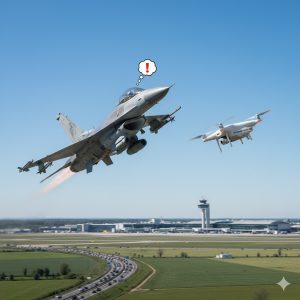In recent weeks, drones have once again dominated the news. Illegal flights over military zones and even Brussels Airport (Zaventem) led to airspace closures. Understandably, both government and citizens are on high alert. Unfortunately, the consequences of these illegal flights are deeply affecting our legitimate operations. For professional drone pilots like us at DroneView.be, it’s becoming increasingly difficult to work safely and undisturbed.
When a Professional is Suddenly Seen as a Threat
We carry out essential daily inspections of rooftops, buildings, and solar panels—detecting thermal anomalies with precision equipment. All flights are performed legally under EU open category rules, at low altitude, and only under safe weather conditions.
Still, we often encounter public suspicion. Just days ago, during a rooftop inspection, someone shouted “I’ll shoot that drone out of the sky!”—despite our hi-vis vests, clearly marked van, and low, legal flight at 20 meters with a thermal camera. No privacy invasion, no dangerous flying—just professional work. And yet, the police were called.

Communication Starts with the Client
We always try to inform authorities properly: registration ready, pre-flight police notifications (especially during current tensions), clear signage on-site. But we’ve found that things run smoother when the client also informs nearby residents. A quick notice can prevent unnecessary panic or hostility.
Strict Rules… with a Small Breakthrough
Thermal inspections depend on sunny conditions and are often scheduled last-minute. But flights near controlled zones like VLL1 or VLL0 require an 8–15 working day application.
Good News from skeyes
skeyes recently confirmed that a request can be submitted for a full-day slot (up to 23h59) and duplicated for several days—making planning easier despite weather dependency.
Lifesaving work: our drones in emergency situations
Last week, a large-scale search operation took place in our neighborhood for the missing person, Noa Jordens from Sint-Truiden. A tremendous, coordinated community effort was launched.
For context: As many as 60 volunteers and 45 search dogs scoured an area of 20 square kilometers. We have nothing but praise for this fantastic, tireless commitment!
We were ready to jump in immediately with our drone and thermal camera – entirely free of charge – but found that the search area was on the edge of an orange zone. Legally, we couldn’t simply start working there.
Our drone with a thermal camera can quickly scan large areas and detect heat sources (people), which is crucial in emergency situations, especially in the dark. This is invaluable when every minute counts.
Our drone can see in 2 minutes what 10 people on the ground (or 10 search dogs) could never cover in the same amount of time.
But here is the double issue: Not only was the area near a controlled zone, the possibility of flying at night – often essential during searches – is not permitted under the basic regulations (Open Category). This raises the question:
What are the possibilities for professional pilots to assist in emergency situations? Is an emergency procedure possible via the police or government that lifts both the geozone restrictions and the night flight restrictions? Should we refuse such an assignment, even if every minute counts? We have posed this question to the competent authorities and are awaiting an answer. As soon as we get clarification, we will update this blog.
IMPORTANT: Concern about the disappearance of Noa Jordens remains high. If you have any information, please contact the police: [Link to search notice].
Focus on Enforcement—But What About the Professionals?
Heavy investment is being made in tracking and intercepting illegal drones. But legitimate operators still face outdated systems, slow processes, and increasing public hostility.
We hope that the rollout of U-space will change that. With USSPs managing airspace clearance, drone pilots will finally have faster, more efficient authorization—without relying entirely on air traffic control.
Our Promise: Safety, Clarity, and Trust
At DroneView.be, we operate with transparency, safety, and full legal compliance. We proactively communicate, seek solutions, and welcome collaboration with both authorities and citizens.
But we also ask the same in return: trust in professional drone operators. Not every drone is a toy. Not every flight is suspicious. Sometimes, it’s just someone doing their job—with care and expertise.
Our mission is to make the world clearer from above—with expertise and your trust.
DroneView.be – Insight through altitude.
